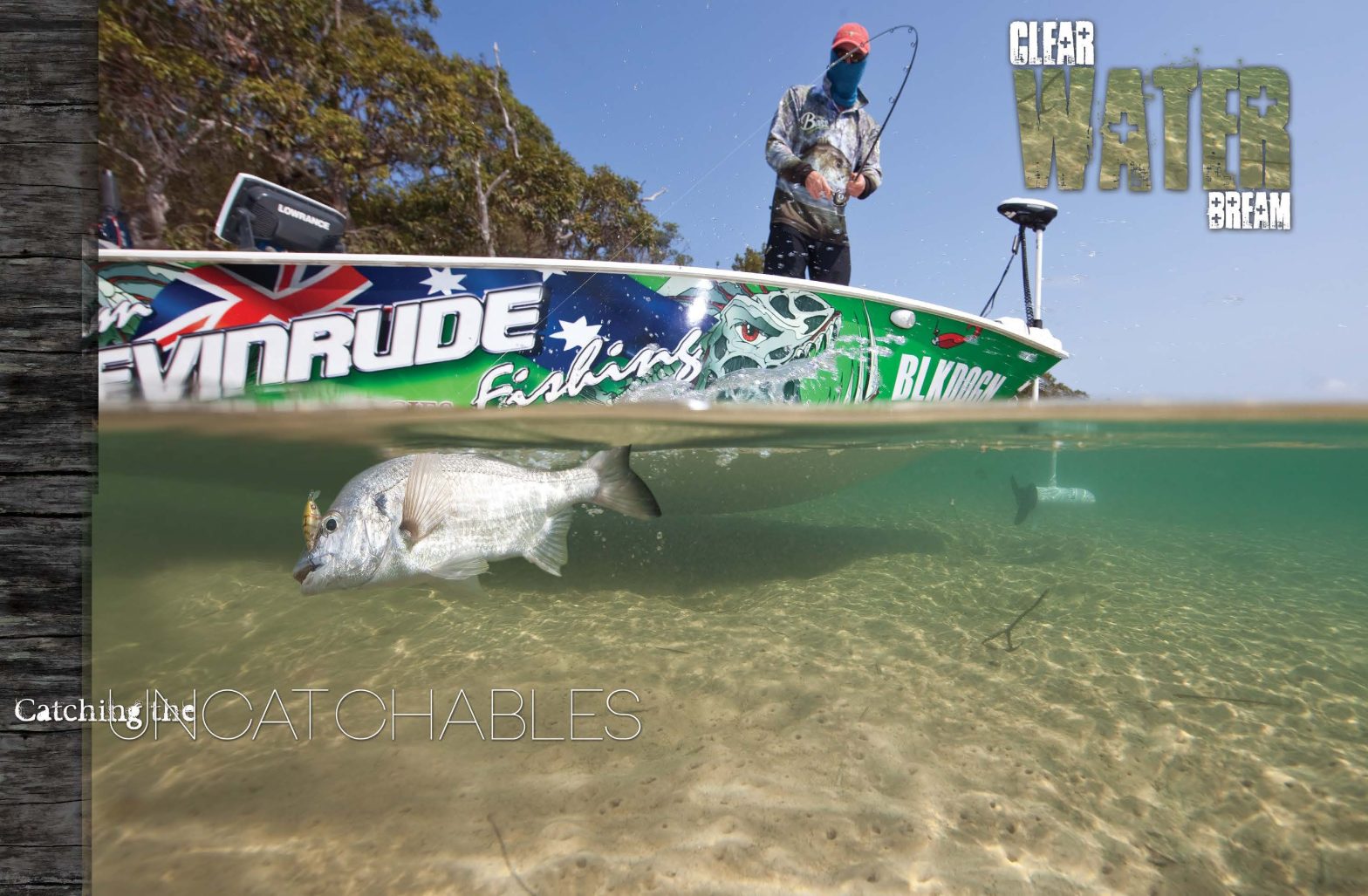Yellowfin bream mooching around in gin clear water is a common enough sight, but catching them is a lot more difficult than just watching them. In this article, Scott and Coen Amon give the lowdown on techniques that work a treat for these often-shy, wary fish.
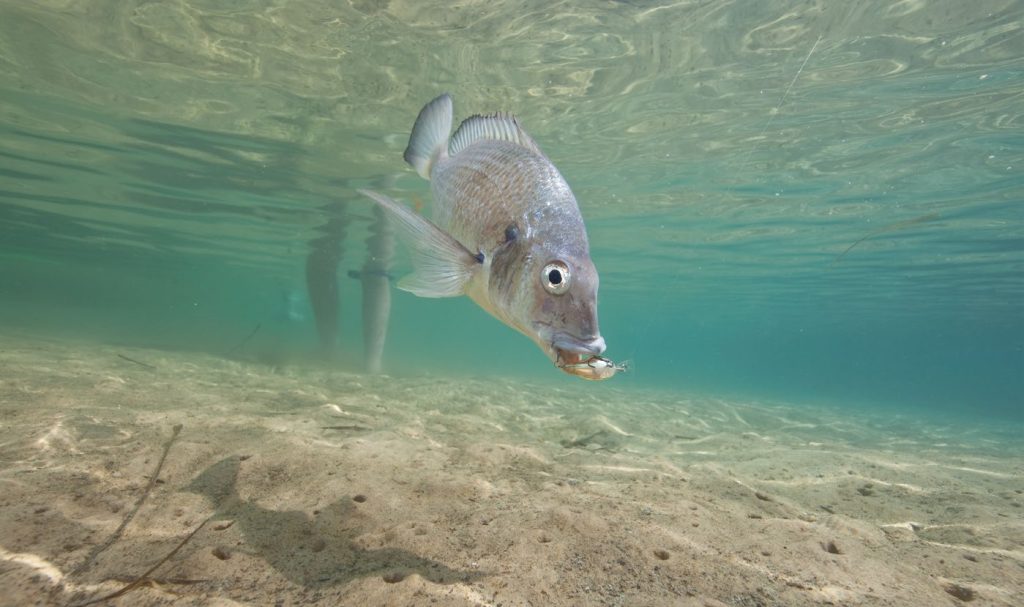
Whether wading or casting, catching quality bream in clear water relies largely on stealth. A very long cast directed at a sandy patch amongst ribbon weed was this fish’s undoing
Any estuary-oriented angler that resides in the southern two thirds of this continent is likely to be a big fan of the ubiquitous bream. And how could they not be popular? Bream are usually the most prolific species within an estuary; readily accept a wide range of both lures and baits; pound for pound perform splendidly once hooked; range from the ocean well into brackish and even fresh water; are an attractive looking fish with a growth potential of 60cm and an impressive 4kg; and finally, they are very good on the plate. Despite these attributes, they can also be one of the most frustrating of all species to catch. While bream will throw caution to the wind and feed aggressively and uninhibited at times, they are more renowned for being fickle feeders. The bigger they are, the more cautious they tend to become at feeding time. Throw into the mix gin-clear water, and quality bream can prove to be one of the most demanding estuary targets. The other incredibly frustrating feature about bream is their tormenting habit of merrily swimming around in full view of all and sundry — including anglers. Those who have had a crack at seducing bream in this situation have usually given up in despair. It’s such a common scenario that many anglers simply bypass these visible fish, dismissing them as uncatchable. I was in that camp for many years too! Over the last couple of seasons though, my son Coen and I have been plugging away in our local estuaries and began to crack the code of these clear-water bream. The following is a description of the techniques and tackle that have allowed us to now catch those big silver-sided fish that we once thought were too cluey and switched on to be fooled. Clear-water Haunts Along with some refinements in tackle and technique, one of the major secrets to success on wary bream in clear water is to spot them before they spot you. Even better, don’t make visual contact with them at all. Where, you might ask, should you fish then? The simplest answer to this question is to dedicate a session or two in your favourite estuaries, either on foot or casually poking around in a boat (preferably under ultra quiet electric motor power), observing where the bream are at various stages of the tide. Yes, you’ll spook a heap of fish, but store these spots in the memory bank to fish later or on another day. Attempt to get an idea of what they are doing in these locations. Are they facing into the current waiting for food? Are they scratching around in the shallows sifting the sand, or are they hovering around rocks or wharf and bridge pylons delicately plucking off tasty items? Employing your powers of observation, then making mental notes to be acted upon in later sessions, is the key. As an example, we started to unlock the secrets of these big, clear-water fish while killing time waiting for prime tide periods for chasing flathead or whiting. Critical lessons were learned while silently gliding up into shallow bays on electric power on the last of a making tide. We had no great expectations in these ultra-clear shallows — a mix of ribbon weed beds and sand or silty bottom. Small, shallow running minnows in transparent and semi-transparent colour schemes were cast well ahead of the boat. Yes, we spooked a lot of fish — mullet, blackfish, flathead and bream — but we also managed to pin a few quality examples of the latter that gave a very energetic account of themselves in such skinny water. That session saw us catch fish that we would not have given a second glance to before. Numbers of other boats were blasting straight past us to the main channels and deeper parts of the system, so we had this new hot spot all to ourselves. As our knowledge base of where the bream were most likely to be holding began to grow, ensuing sessions saw us catch more and spook less. We didn’t wait to see fish or water movement, we started to trust in our newly acquired information. After enjoying tremendous success on bream and the odd good flathead and blackfish in a number of extremely shallow bays, we used a similar technique to fish the slightly deeper (1-2m) main river channel edges adjacent to the shoreline. This particular estuary was crystal clear, with just the odd piece of dead timber, overhanging mangroves and wave-like sandy bottom contours. But quality bream these clear shallows did hold. For the life of me I couldn’t see them, but there they were alright, sitting in the shadows cast by the timber or mangroves, and even in the slightly darker recesses of sand. Shadows are another favoured haunt, be it tiny slivers of dark thrown by a single stick or log, or deeper shade cast by overhanging trees, jetties, moored boats or rocky edges. Rarely will you spot bream holding in shadows. Rather, they see you and all you catch of them is their tails waving you goodbye. Different estuaries offer different clear-water haunts for bream, but doing that one or two trip reconnaissance to poke around and observe their preferred lairs is a sound investment in future success.
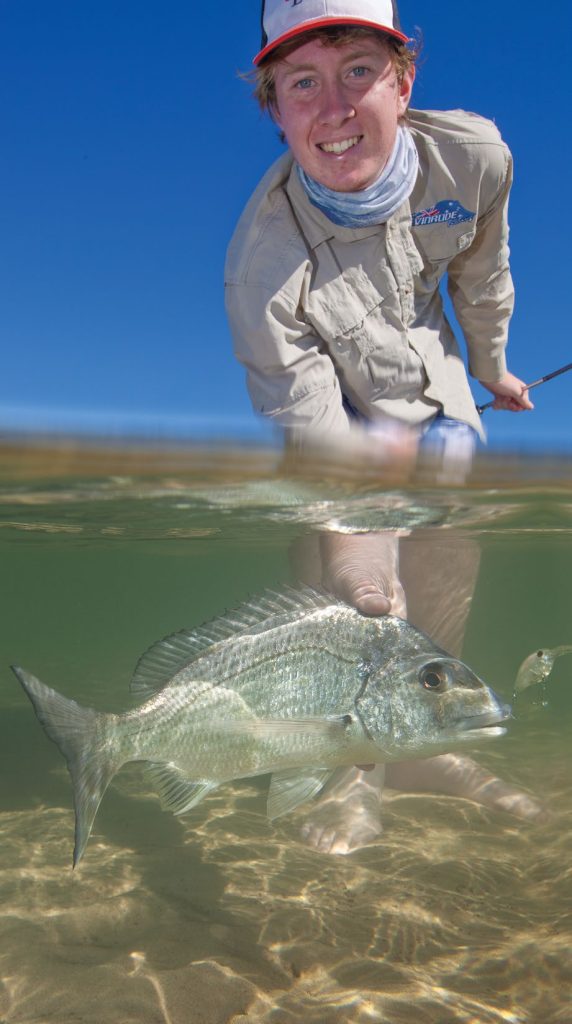
A deeper diving minnow did the trick, tempting a stud bream from a sandy depression in the main river channel on a bright sunny day.
Essential Stealth The larger bream present in most estuaries have not established their maturity without some inbuilt survival instincts. They have most likely had many baits and lures thrown at them previously, and might have been caught once or twice at some stage in their lives. They are generally cunning and well educated about the ways of anglers. A fish of 30cm fork length may be up to 14 years old or more, according to a study from the DPI’s Wild Fisheries Research Program. That’s a long time at survival school. Like most shallow water fish, bream have a highly efficient lateral line and sensory system, which are delicately tuned to detecting vibrations and scents. This only adds to the need for attention to detail by the angler. To give us the best chance of success with these often ‘educated’ bream, we use extra-long, light leaders on the end of braided main line. ‘The longer the better’ is in order to keep the more visible braid of the main line out of sight. Generally at least two drawn out arm lengths of 2kg (4lb) monofilament or fluorocarbon is required. Keep in mind too, that thinner diameter leaders create less vibration/water movement when travelling through the water. They are also less visible than thicker leaders, all of which may spook already wary fish. Whether fishing out of a boat or on foot, water movement, motor noise, even just the shadow of the boat or angler effectively creates a ‘flight zone’ or ‘bubble’ that may extend 10-20m depending on conditions. Fish within this bubble are almost certainly aware of your presence, and of course less likely to feed freely. Take time to monitor and learn the varying size of your ‘flight zone’ in changing environments and conditions. Long casts, well away from the zone, are vital when chasing big bream in shallow water. We’ve noted that the greater the distance, the more hits. Casts should be directed at likely haunts as mentioned above and fanned out in as wide an arc as possible, before walking on or drifting forward under electric motor propulsion.
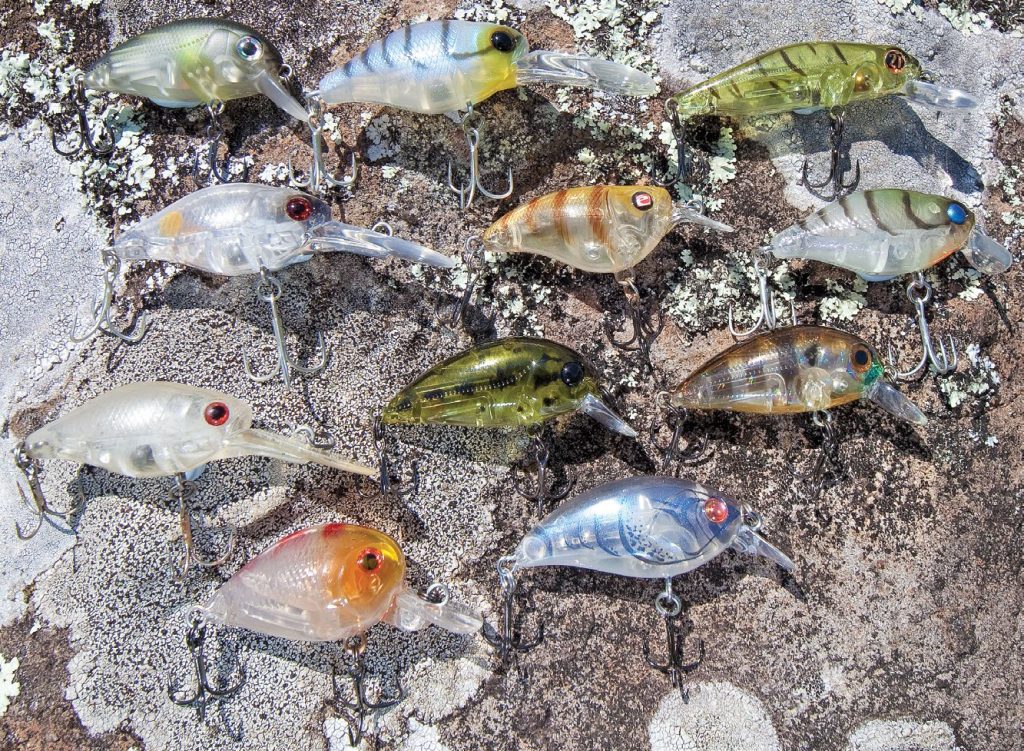
A selection of extremely lifelike minnows in transparent patterns that work so well on bream in clear water.
Clear-water Hardware While small soft plastics are outstanding catchers of bream in the right locations and situations, we have found that they’re not as effective as hard-bodied divers for this shallow water. The latter cast like little bullets from quality lightweight threadline outfits, whereas casting small plastics any great distance requires the use of cumbersome and impractical sized jig heads. Hard-bodied minnows also offer floating, suspending or slow sinking capabilities depending on the lure, while retaining distance castability. An important factor when choosing a good hard body for this style of fishing is the standard of its build. A quality design and mould will produce a lure with clean lines and improved hydrodynamics, that will in turn deliver a superior swimming action. The Japanese are masters of this art and their manufactured or designed lures are far superior to your average run-of-the-mill Chinese alternative. This is gradually changing, however, and some quality lures are now being made in China.
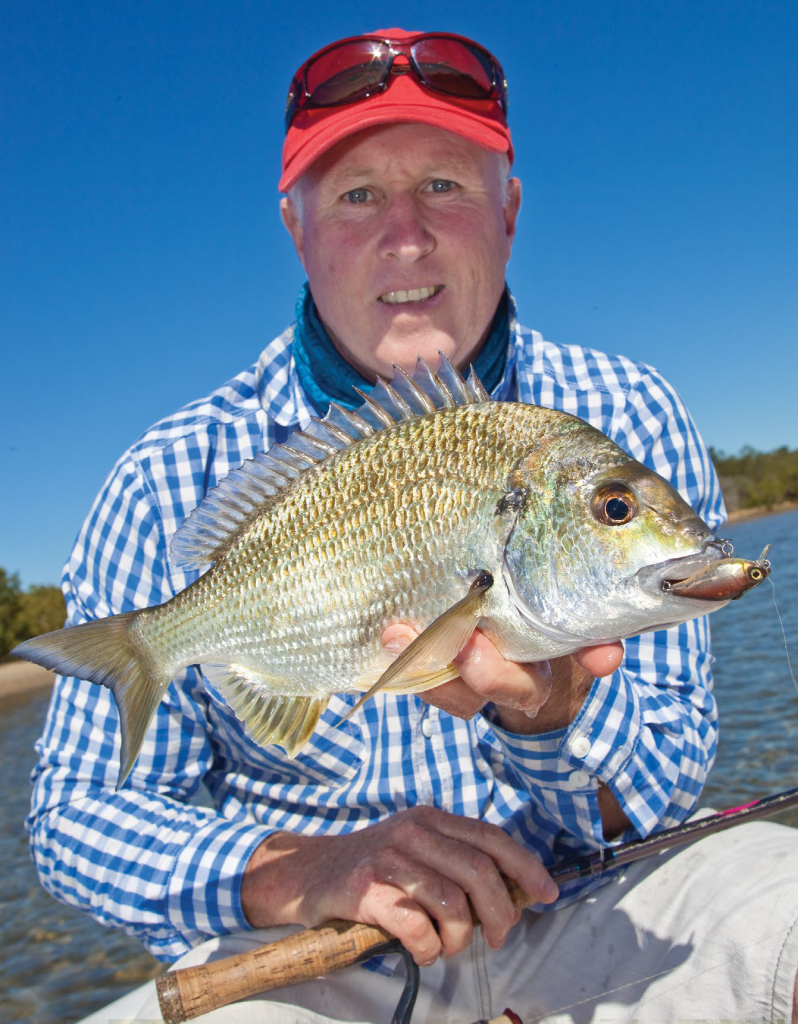
Bream from clear water show brilliant colouration and are
almost always striking examples of the species.
Price, unfortunately, largely reflects the standard of a lure. Quality lure manufacturers are producing finishes that truly replicate the appearance of tiny baitfish. Our personal favourites are those transparent and semi-transparent finishes with subtle, life-like glowing hues to them. They virtually have a three dimensional look. Retrieve styles for this type of minnow vary immensely for differing applications, but we have found a very slow roll of the reel handle is the killer approach to clear-water bream. Adding the occasional 2-5 second pause can, at times, trigger reluctant fish into eating a lure. Twitching style retrieves commonly used for other forms of fishing will spook them. A slow constant roll works a treat and if you feel a hit but fail to connect, stopping the retrieve and allowing a floating lure to creep back to the surface can send the bream nuts. I’ve had numbers of fish fighting over a stationary floating lure! There’s not a whole lot more to the approach than that, and while we’ve only fished this way for yellowfin bream, we’re pretty sure their black southern cousins will respond to these methods too. Certainly, the more you do of this sort of fishing, the better you get at it. The more you think outside the square, and put lures into places that you previously ignored, the better the results. Some of the places bream frequent are pretty amazing, and the whole concept of targeting them in clear, skinny water has changed the way we fish. For years we spotted them feeding in the shallows, spooked them, figured they were out of reach, and moved on to tried and tested locations and techniques. Now though, we’ll never look back and are constantly pushing the boundaries of where and when a bream can be caught. Even the seasons don’t seem to matter too much. We’ve caught them this way throughout the year, although there are some short periods when they are light on in numbers for one reason or another. We’ll never tire of honing the skills required to stalk bream in this manner. It heightens all the senses and creates a concentration corridor between you and the fish that is very personal. Then of course there is the grand finale, when a big slab of silver slams the light line tight and roils the sand as it rips off through the clear water. They truly are a special fish and we would be much poorer without our magical bream.

Whether fishing on foot or from a boat, stealth is the major
factor in luring bream of this calibre from clear water.
Super long casts with small, bulbous semi-transparent
lures and ultra-slow retrieves are just part of the equation.
Key Tactics • Dedicate one or two recces to establish where the bream hold up at various stages of the tide. Expect to spook a heap of fish initially, but you’ll be well prepared to present lures to them next time round. • Plan your approach so that long casts can be made to known bream holds. Wind assistance can help with distance. • Lightweight threadline outfits with 1000 size reels loaded with 2kg (4lb) braid will cast small lures further than any other tackle. • Ultra-light leaders of around 2kg breaking strain or less offer added stealth. Use at least half to one full rod length of leader. • High quality (read Japanese made or designed) compact shallow to medium depth running lures cast well and swim consistently. Transparent and semi-transparent colour patterns that mimic prawns, yabbies and bait fish work wonderfully well in clear water. • Slow rolling retrieves with the occasional pause tend to work better in clear water than jerky retrieves. • Pay special attention to shadows cast by all manner of items, from sticks to rocks, pylons to sandy hollows. • Large, shallow expanses with patches of ribbon weed are prime clear-water bream possies.

